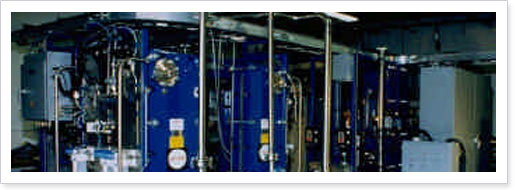50 kW Fuel Cell Test Facility
The Problem:
In 1839, Grove demonstrated that electrolysis of water could be reversed using platinum electrodes and created the first fuel cell. A fuel cell is an electrochemical device in which electrical energy is generated by chemical reaction without altering the electrodes and electrolyte of the cell itself. This feature distinguishes the fuel cell from the storage battery.

More recently, the Department of Energy (DOE) has become interested in the fuel cell as a nonpolluting automotive power plant. DOE grants were made to the big three to develop a 50-60 kW fuel cell suitable for small vehicles. Emprise was selected by Chrysler/AlliedSignal and General Motors (Delphi Division) to supply their scientists with the research equipment they needed to meet the DOE challenge.
The central problem in fuel cell design revolves around "the stack." This arrangement of anodes, cathodes and electrolytes is responsible for the conversion of chemical energy to electrical power. Stacks are tested by passing fuel (usually hydrogen) and oxidant (usually air) through alternate plates in the stack. In the research setting, these flows must be carefully measured and controlled. Furthermore, it is essential that the gas streams be precisely humidified to avoid drying out the electrolyte and thus stopping the flow of electricity.
The process of measuring, controlling and humidifying the reactants is further complicated by the need to do so over an extremely wide operating range. The test facility must test stacks producing from 500 watts to 60 kW. Operating pressures from 2 to 75 psig and relative humidities from 50 to 100% at temperatures from 50 to 110 degrees C must be simulated. Extraordinary techniques of pressure, temperature and humidity control are necessary to meet these requirements.
The Solution:
Fuel cells require two independent gas flow circuits (the anode and cathode). Each circuit is functionally identical but carefully sized to match the flow associated with each reactant.
Most functions of the reactant circuits are accomplished by ordinary means. Plate type condensers recover the deionized water from the stack exhaust while metering pumps return it for recycling in the humidifiers. Stack ventilation rates are controlled by staged globe valves mounted in the condenser exhausts. A programmable controller provides direct digital control of the test process while a PC serves as the operator interface. Test sequencing, control and data acquisition are fully automatic.
Other process functions are more challenging. Twelve bit digital valves solved the difficult problem of stack inlet pressure control while also providing accurate flow measurement over the full operating envelope. These gas flow measurements are used to calculate the exact amount of water required for reactant humidification. Precision metering pumps inject about 90% of this water into the anode and cathode gas streams. This two phase flow is heated in plate type heat exchangers where the large plate surfaces vaporize the water and heat the gas to a point well above the target dry bulb setpoint. The remaining water is metered to a point downstream of the heat exchanger and atomized by a sonic nozzle. This fine spray creates an adiabatic quench that cools the humidified gas to the exact dry bulb and specific humidity desired for that test. Thus, the total flow through the metering pumps determines the final specific humidity, and the proportion of water used in the process determines the final dry bulb temperature.
The Results:
The AlliedSignal/Chrysler team has begun testing fuel cell designs with their new test facility. The unique system design allows testing of extremely small experimental stacks while retaining the capacity to test full scale vehicle power plants. The ingenious humidification system exhibits precise humidity control and setpoint stability during flow transients. Temperature and humidity transients are simulated simply by varying the speed of the water injection pumps. Acting under computer control, the system can simulate complex transient driving cycles that can quickly identify power plant problems before they appear in the field.
The Emprise fuel cell test facility design is helping to pave the way for the low emissions vehicles of the future.